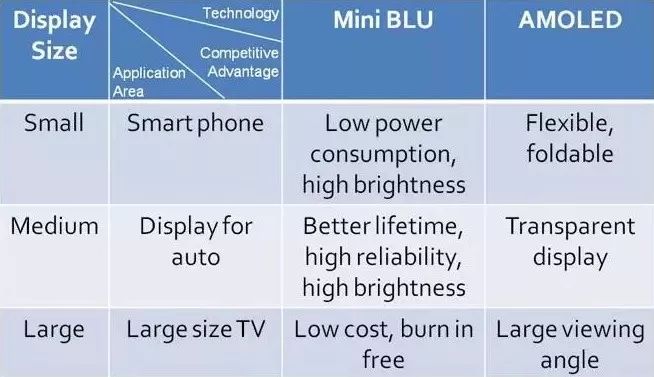With the release of LED chip factory capacity in the mainland this year, Huacan, Sanan, Ganzhao, Jucan, Zhaochi, Shilan and other new production capacity will increase ~50% of the existing capacity. So many newly released production capacity urgently needs a window that can be digested. However, Micro LED technology is like the moon in the sky. For most people, it is currently elusive. The Mini LED thus turned out to be the cusp of a new era.
So what exactly is the Mini LED, what applications does the Mini LED have, and what advantages and disadvantages does the Mini LED have over other display technologies? This article will interpret these issues from the perspective of Mini LED technology developers.
According to the current definition of the industry, Mini is a slightly larger size than Micro, and its size is approximately between 80-300 μm. LED chip practitioners had already been making LED chips in the Mini dimension before the word Mini LED appeared. However, the main chips produced at that time were LED chips based on suits. The applications in the display field were mainly conventional indoor and outdoor applications. The display screen and the small pitch display screen. In order to differentiate the LED chiplets used in the display, the Mini LED was created to refer to flip chip LED chips with a chip size of 80-300μm for display applications. The main difference between the small-pitch LED, Mini LED, and Micro LED on the display chip is shown in the following table.

Mini LED has two main applications in display, one is self-luminous LED display, similar to small-pitch LED, because the package form does not require gold wire, compared to small-pitch LED, even in the same chip size Mini LED can also be used for smaller dot pitch display. The other is the application on the backlight. Compared to traditional backlight LED modules, the Mini LED backlight module will use a more dense chip arrangement to reduce the mixing distance and achieve an ultra-thin light source module. In addition, with the local dimming control, Mini LED will have better contrast and HDR display.
Due to the limitations of Mini LED chip size and packaging technology, the Mini LED of the RGB self-luminous display application can currently achieve a point spacing limit of substantially 0.5 mm. When a 4K screen is formed, the entire screen size reaches 85 inches or more, and The use of a large number of LED chips (~ 24 million) makes the screen extremely expensive, in order to enhance the competitiveness of the LED display market, improve the display quality of the original LCD backlight, Mini LED applications in the field of backlight (below using Mini BLU To represent) has been increasingly valued by the industry, and is often used to compare with AMOLED.
The advantages and disadvantages of Mini BLU and his several display technologies are compared as follows. In the display of several of the most basic elements include, power consumption, cost, life, dot spacing, brightness, contrast, Mini LED is basically a all-around player. However, today, AMOLED has been in full bloom, Mini LED products in the field of backlight applications are still being questioned, but have not entered the market. Of course, this is mainly due to the fact that the Mini BLU technology reserves are relatively late (mainly starting in the second half of the 17th year), and partly because it is still LCD-based display technology. Even LED chip practitioners will take it for granted that his display will be inferior to AMOLED, and he will position it under AMOLED.

but it is not the truth. Compared to AMOLED, Mini BLU has undoubted advantages in terms of cost and longevity. Because LED chips have higher photoelectric conversion efficiency than OLEDs, and with local dimming control, Mini BLUs have near-to-even lower power consumption, and therefore can achieve higher contrast and higher brightness. The dot pitch is mainly limited by the LCD technology, and it is now possible to achieve better than self-luminous AMOLED.
Based on the above advantages, Mini BLU can always find its place in a suitable field. Whether or not AMOLED has insufficient capacity, it must be reliable. Of course, as consumers are increasingly pursuing personalization, the Mini BLU also has a fatal weakness that cannot be made flexible (but it can still be curved), which is mainly limited by LCD technology.
In terminal applications, from small screens such as mobile phones, PADs, to mid-screens such as cars, monitors, to large screens such as TVs, Mini BLUs and AMOLEDs, each has its own competitive advantage, and one-and-a-half minutes may not replace anyone else. Especially in the car, as well as on the big screen display, Mini BLU will have more obvious cost advantages and better life and reliability, these will be the advantages that AMOLED can not replace.

Finally, whether it is Mini LED or AMOLED, let us wish together and work together to make our future display products better and better. I also wish all LED technology practitioners can ascend to the moon on that day as soon as possible.
There are some draft products here, which will not be displayed on the website. These products can be modified later to enrich the content of the website. If you want to know more about our company, you can go to our website to check, there will be what you want, or you can consult us. Nice to meet you and looking forward to our cooperation.
Draft-waiting For Releasing,Draft-waiting For Releasing,Draft-waiting For Releasing
ETOP WIREHARNESS LIMITED , https://www.wireharnessetop.com